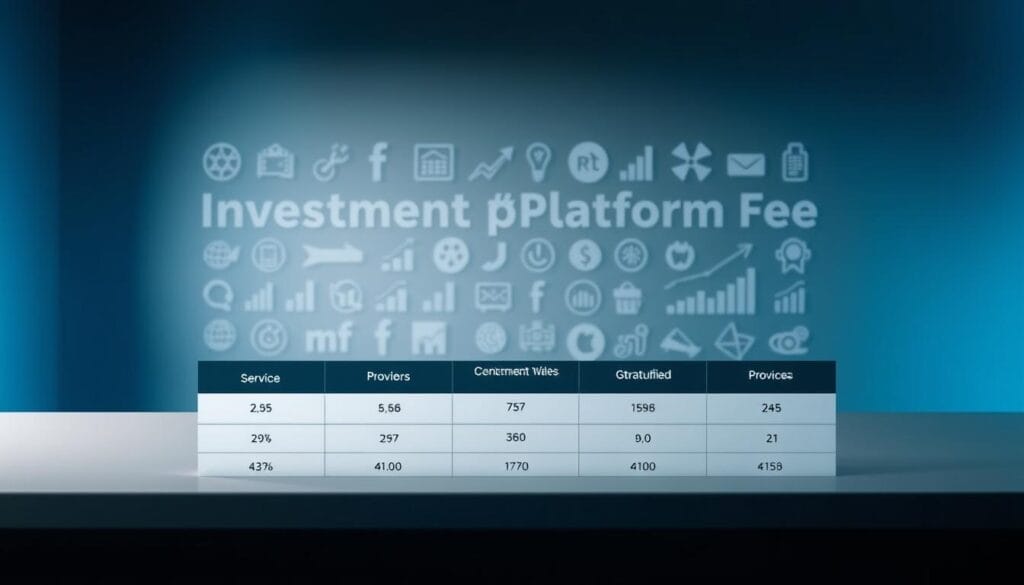By 2025, digital wealth management tools are projected to oversee nearly $754 billion in assets, transforming how Americans secure their financial future1. Morningstar’s latest report ranks Vanguard Digital Advisor as the top performer, thanks to its low-cost structure and hybrid approach combining automation with certified financial planners1.
The industry’s rapid evolution now prioritizes personalized strategies, including tax optimization and ESG-aligned portfolios. Firms like Betterment and Wealthfront lead with innovations such as crypto ETF integration and automated tax-loss harvesting2.
Traditional players like Fidelity and Schwab have adapted by blending digital efficiency with human expertise, ensuring compliance with IRS regulations while catering to diverse investor needs3.
Key Takeaways
- Vanguard leads with low fees (0.20%) and hybrid advisor access1.
- Tax-loss harvesting and ESG options are now standard features.
- Hybrid models dominate, merging automation with human guidance.
- Crypto ETFs and private equity access attract high-net-worth clients.
- Portfolios are tailored via risk-assessment questionnaires.
What Are Robo Advisors for Retirement Planning?

Cutting-edge algorithms analyze risk tolerance to create diversified portfolios automatically4. These platforms use ETFs to ensure broad market exposure, adjusting allocations based on real-time data and investor goals5.
How Automation Transforms Investment Management
Algorithms maintain target allocations through automated rebalancing, reacting to market shifts without manual intervention4. Tax-loss harvesting, offered by firms like Schwab and Vanguard, further optimizes returns by offsetting gains with losses6.
Fidelity Go’s zero-expense ratio Flex funds exemplify cost efficiency, while Vanguard’s 0.20%–0.25% fee structure outperforms traditional advisors charging 1%+5.
Advantages of Algorithm-Driven Strategies
Lower fees translate to tangible savings. A $500,000 portfolio could save $3,750 annually compared to human advisors4. Features like Required Minimum Distribution calculations cater specifically to long-term financial goals5.
“Automation ensures consistency in portfolio management, removing emotional biases from investment decisions.”
Accessibility is another key benefit. With low or no account minimums, these platforms democratize investment management for all investors6.
How Robo-Advisors Build and Manage Your Portfolio

Modern investment platforms leverage advanced algorithms to tailor portfolios based on individual financial profiles. These tools begin with an online survey assessing goals, risk tolerance, and time horizons to determine the optimal strategy7.
The Role of Risk Tolerance Questionnaires
Dynamic questionnaires, like Wealthfront’s 20-tier system, fine-tune asset allocation by gauging an investor’s comfort with volatility8. Fidelity’s simpler 8-tier approach still ensures portfolios align with long-term objectives6.
Results dictate the mix of ETFs, balancing stocks, bonds, and alternative assets for diversification7. Schwab’s controversial cash allocations (6%–30%) highlight how platforms adjust for risk preferences6.
Automatic Rebalancing and Tax Optimization
Algorithms trigger rebalancing when deviations exceed 5% from targets, maintaining the intended asset allocation7. Vanguard’s 4-ETF core portfolio exemplifies this efficiency, adjusting to market changes seamlessly6.
Tax optimization features, like cross-account coordination, maximize after-tax returns. Merrill’s bond laddering and SigFig’s emerging debt analysis further enhance retirement income strategies8.
“Automated rebalancing removes emotional decisions, ensuring portfolios stay aligned with financial goals.”
Platforms like E*TRADE integrate smart beta ETFs and socially responsible investments, offering customization beyond basic tax optimization7.
Factors to Consider When Choosing a Robo-Advisor

Investors must weigh multiple criteria when evaluating automated wealth management solutions. Fees, investment options, and advisory support dramatically affect long-term outcomes. Below are critical factors to analyze before committing to a platform.
Management Fees and Expense Ratios
Costs vary widely across platforms. Vanguard charges just 0.20% annually, while Betterment Premium’s *fee* climbs to 0.65% for advanced features like tax coordination9. Titan imposes a steep 1.87% *expense ratio* for accounts under $15,000, making it less competitive for small investors.
Some providers offset costs creatively. Schwab allocates 10% to cash reserves, effectively waiving advisory *fees*10. Always compare net *expense ratios*, not just headline rates.
Account Types and Investment Options
Platforms differ in supported *account types*. Schwab excels with Roth IRA conversions, while Betterment supports SEP IRAs for freelancers10. Niche options like crypto ETFs (Betterment) or REITs (SigFig) cater to specialized strategies.
Hidden costs matter too. Wells Fargo uses a sliding scale (0.25%–0.35%), whereas E*TRADE charges a flat 0.3%10. Review all potential charges before funding an account.
Access to Human Advisors
Hybrid models blend automation with expert guidance. Fidelity grants *access* to CFPs at $25,000, while Vanguard requires $50,00010. SoFi stands out by offering free CFP consultations, ideal for beginners11.
“Human oversight adds value for complex scenarios, like estate planning or sudden windfalls.”
Prioritize platforms aligning with your need for *services*—whether fully automated or hybrid. Lower *fees* shouldn’t compromise essential features like tax-loss harvesting or *account types*.
Top Robo-Advisors for Retirement Planning in 2025

The landscape of automated wealth management continues to evolve with standout performers in 2025. These platforms blend low costs, advanced tools, and personalized strategies to help investors achieve long-term goals.
Vanguard Digital Advisor: Best for Low-Cost Investing
Vanguard’s patented Life-Cycle Investing Model adjusts portfolios based on age, targeting optimal mutual funds and ETFs1. With a $100 minimum and 0.20% fee, it includes CFP access for accounts over $50,00012.
Its 90-day fee waiver and tax-efficient strategy make it ideal for cost-conscious investors1.
Fidelity Go: Ideal for Beginners
Fidelity’s free tier for balances under $25,000 uses zero-expense-ratio Flex funds and FDIC-insured cash positions12. The platform requires just $10 to start, appealing to new investors.
Betterment Premium: Advanced Planning Tools
For 0.65% annually, Betterment offers CFP access and glide-path customization for phased withdrawals12. Its tax-coordination feature optimizes mutual funds across accounts13.
Schwab Intelligent Portfolios: Tax-Efficient Strategies
Schwab’s S&P 500 Index Fund (SWPPX) boasts a 0.02% expense ratio and automated tax-loss harvesting13. Despite its $187M SEC settlement, it remains a top pick for ethical advisory services1.
“The right platform balances cost, customization, and compliance—key for sustainable growth.”
Comparing Fees and Services Across Providers

Fee structures significantly impact long-term investment growth, making comparisons essential. While automated platforms typically charge 0.25%–1.0% in management fees, expense ratios and add-ons can drastically alter total costs14.
Fee Structures: From Free to Premium
Basic tiers often appeal to beginners. Acorns charges $3 monthly, equivalent to 2.53% for its average $1,425 balance—a steep cost for small accounts15. Empower’s 0.89% starting fee includes CFP access, justifying its premium pricing14.
Hybrid models like Vanguard blend low fees (0.20%) with human guidance at $50,000+ balances15. Always compare net costs, including fund-level expenses.
Additional Services Worth Paying For
Value-added tools differentiate providers. Wealthfront’s college savings plans contrast with Vanguard’s estate planning integrations15. Tax-loss harvesting, standard on platforms like Schwab, can boost after-tax returns by 1%–2% annually.
SoFi bundles banking services at 0.25%, while Betterment Premium (0.65%) offers glide-path adjustments for phased withdrawals14.
“Break-even analysis reveals premium features often pay for themselves via tax savings or higher returns.”
Morningstar’s 2025 rankings weight pricing at 30%, emphasizing cost-to-value ratios15. Investors should prioritize platforms aligning financial planning needs with transparent fee structures.
How to Open a Robo-Advisor Account

Opening an automated investment account takes minutes with streamlined digital processes. Most platforms require basic personal details and a quick risk assessment to tailor your portfolio16.
Step-by-Step Onboarding Process
Identity verification is standardized across platforms, using Social Security numbers and photo IDs. Vanguard mandates a $100 minimum per enrolled account, while SoFi’s BlackRock partnership allows $1 starts1617.
Funding options include ACH transfers (Wealthfront: $500 minimum) or ACATS for existing account transfers. Fidelity Go requires no minimum, ideal for beginners17.
Funding Your Account and Setting Goals
Goal-setting tools vary by platform. Betterment’s timeline sliders project investments over time, while Vanguard’s debt calculators optimize payoff strategies16.
Account aggregation features, like Empower’s dashboard, consolidate money across institutions. Security protocols, including two-factor authentication, protect your balance16.
“Digital onboarding eliminates paperwork, letting investors focus on long-term growth.”
Tax Advantages and Retirement Accounts

Tax-efficient strategies can significantly boost long-term wealth accumulation. Automated platforms optimize retirement accounts like IRAs and 401(k)s, leveraging rules to minimize liabilities18.
Maximizing IRA and 401(k) Benefits
Backdoor Roth IRA conversions are streamlined through digital platforms, bypassing income limits19. Vanguard’s 401(k) management requires employer partnerships but offers low-cost funds with tax-deferred growth16.
HSAs (Health Savings Accounts) are increasingly integrated into portfolios, providing triple tax advantages for medical and retirement expenses18.
Tax-Loss Harvesting Nuances
This strategy saves investors ~0.5% annually but requires $50,000 minimums and careful wash-sale rule compliance1819. Municipal bonds offer federal tax exemptions but may incur state taxes or AMT16.
“State-specific tax rules can alter bond returns by 2%–3%, making localization critical for after-tax gains.”
Treasury bond allocations vary by state—some exempt interest income, while others tax it16. Always review platform-specific tax logic before committing investments.
Common Pitfalls to Avoid with Robo-Advisors
Automated wealth management isn’t foolproof—investors must recognize common missteps. While algorithms streamline investments, hidden costs and rigid strategies can erode returns if overlooked20.
Overlooking Hidden Fees
Platforms like Titan charge $250 annually for premium features, while Citi bundles undisclosed fund expenses into portfolios20. Merrill’s $20,000 account minimum also triggers steep fee cliffs, catching small investors off guard21.
Compare cash allocations carefully. Schwab’s 6%–30% cash drag contrasts with Ally’s 30% Cash-Enhanced portfolios, impacting liquidity and growth22.
Ignoring Risk Tolerance Updates
Standardized algorithms lack personalization, often failing to adjust for life changes like job loss or inheritance22. Vanguard’s 7% non-ESG bond allocation, for example, may clash with ethical preferences21.
“Automation can’t replace human intuition when markets fluctuate unpredictably.”
Rebalancing frequency matters too. Quarterly adjustments may lag behind threshold-based systems, leaving portfolios misaligned with goals22.
Behavioral gaps are another concern. Automated systems can’t soothe panic during downturns, potentially leading to premature withdrawals20.
Expert Strategies for Maximizing Returns
Sophisticated asset allocation techniques can amplify portfolio performance while minimizing risk. Modern platforms leverage diversification across asset classes, from equities to inflation-protected securities, to stabilize returns during market shifts23.
Diversification and Long-Term Growth
Tax optimization is key. Platforms place tax-inefficient assets like bonds in IRAs, while equities reside in taxable accounts to capitalize on lower capital gains rates23. This strategy boosts after-tax returns by 0.5%–1.5% annually24.
For ultra-high-net-worth clients, custom indexing tailors portfolios to individual holdings, avoiding overlap with broad-market ETFs23. Vanguard’s $5M private equity tier further diversifies exposure beyond traditional market instruments23.
When to Combine Automation with Human Advice
Hybrid models excel during volatility. Wealthfront’s algorithms manage concentrated stock positions by rebalancing quarterly, while human advisors adjust for life events like inheritances23.
“A $1M portfolio with Vanguard PAS saw 12% higher returns over 5 years by blending automated tax harvesting with CFP-guided estate planning.”
Morningstar’s criteria emphasize cost-to-value ratios. Investors should prioritize platforms offering inflation hedges (e.g., TIPS) and behavioral coaching to prevent panic selling2324.
Conclusion
Automated wealth management tools now dominate the financial landscape, offering cost-efficient solutions for long-term growth. With fees averaging 0.23%—far below traditional 1.02% advisor rates—these platforms democratize access to sophisticated strategies2526.
Low-cost leaders like Schwab charge no advisory fees, while premium services provide hybrid human support for complex needs9. AI-driven tax optimization and automatic rebalancing further enhance returns, aligning with SEC compliance standards25.
For actionable next steps, investors should evaluate their financial planning goals. Beginners may prefer no-minimum platforms, while high-net-worth individuals benefit from customized portfolios. Learn more about institutional trust factors in this FPA analysis.
The future lies in blending algorithmic precision with selective human insight. This balanced approach maximizes both efficiency and adaptability for diverse investment profiles9.
FAQ
How do automated investment platforms help with retirement?
What fees should investors watch for?
Can these services handle 401(k) rollovers or IRAs?
How often should portfolios be rebalanced?
What happens during market downturns?
Are human financial advisors available if needed?
How quickly can accounts be funded?
FAQ
How do automated investment platforms help with retirement?
These platforms use algorithms to create and manage diversified portfolios based on individual goals, risk tolerance, and time horizon. They automatically rebalance assets and optimize tax strategies.
What fees should investors watch for?
Management fees typically range from 0.15% to 0.50% annually. Some providers charge additional costs for premium services or certain account types. Always review expense ratios on mutual funds and ETFs.
Can these services handle 401(k) rollovers or IRAs?
Most top platforms support traditional, Roth, and SEP IRAs. Some offer 401(k) rollover assistance. Vanguard and Fidelity provide specialized retirement account options with tax-efficient strategies.
How often should portfolios be rebalanced?
Leading services automatically adjust allocations quarterly or when market movements cause significant drift from target percentages. This maintains the desired risk level without manual intervention.
What happens during market downturns?
Algorithmic systems follow predetermined strategies rather than emotional decisions. They may increase tax-loss harvesting during volatility and maintain long-term asset allocations aligned with the investor’s profile.
Are human financial advisors available if needed?
Hybrid models like Betterment Premium and Schwab Intelligent Portfolios offer access to certified financial planners for complex situations, typically for accounts above certain balance thresholds.
How quickly can accounts be funded?
Electronic transfers usually take 2-3 business days. Some platforms allow immediate trading with uninvested cash while transfers complete. Minimum deposits range from
FAQ
How do automated investment platforms help with retirement?
These platforms use algorithms to create and manage diversified portfolios based on individual goals, risk tolerance, and time horizon. They automatically rebalance assets and optimize tax strategies.
What fees should investors watch for?
Management fees typically range from 0.15% to 0.50% annually. Some providers charge additional costs for premium services or certain account types. Always review expense ratios on mutual funds and ETFs.
Can these services handle 401(k) rollovers or IRAs?
Most top platforms support traditional, Roth, and SEP IRAs. Some offer 401(k) rollover assistance. Vanguard and Fidelity provide specialized retirement account options with tax-efficient strategies.
How often should portfolios be rebalanced?
Leading services automatically adjust allocations quarterly or when market movements cause significant drift from target percentages. This maintains the desired risk level without manual intervention.
What happens during market downturns?
Algorithmic systems follow predetermined strategies rather than emotional decisions. They may increase tax-loss harvesting during volatility and maintain long-term asset allocations aligned with the investor’s profile.
Are human financial advisors available if needed?
Hybrid models like Betterment Premium and Schwab Intelligent Portfolios offer access to certified financial planners for complex situations, typically for accounts above certain balance thresholds.
How quickly can accounts be funded?
Electronic transfers usually take 2-3 business days. Some platforms allow immediate trading with uninvested cash while transfers complete. Minimum deposits range from $0 to $5,000 across providers.
What investment options are typically available?
Portfolios generally consist of low-cost ETFs covering domestic and international stocks, bonds, and sometimes alternative assets. Asset allocation varies based on the selected risk level and retirement timeline.
to ,000 across providers.
What investment options are typically available?
Portfolios generally consist of low-cost ETFs covering domestic and international stocks, bonds, and sometimes alternative assets. Asset allocation varies based on the selected risk level and retirement timeline.
Source Links
- The Best Robo-Advisors of 2025
- Best Robo-Advisors for April 2025
- Best Robo-Advisors Of 2025
- What Is A Robo-Advisor? Definition and How It Works – NerdWallet
- Robo Advisors for Retirement Planning – How Do They Work
- Robo-Advisors vs. Financial Advisors: Which One Fits Your Financial Needs Best? | Bankrate
- How can a robo-advisor help me invest?
- Automated Investing with Guidance — Vision Retirement
- Robo-Advisor: Advantages and Disadvantages
- How to Pick the Best Robo Adviser For You
- Robo-Advisors vs. Financial Advisors: How to Choose – NerdWallet
- Morningstar IDs Best Robo-Advisers of 2025 | PLANADVISER
- Best Robo-Advisors In April 2025
- How Much Does a Financial Advisor Cost? (Updated for 2025)
- Best Robo-Advisors: Top Picks for 2025 – NerdWallet
- Robo-Advisor – Automated Investing Services | Vanguard
- How to Invest $1,000: Open a Robo-Adviser Account
- 5-Step Tax-Smart Retirement Income Plan
- How to Use Your Robo-Advisor to Save on Taxes
- Are they worth the Hype?
- Robo-advisors are dead, long live robo-advisors
- What Are The Pros & Cons of Robo Advisors ? | FinEdge
- Your Guide to Robo Advisor Investment Strategies
- Level Up Your Investing Strategy: 7 Smart Ways To Transform Your Approach
- The Future of Financial Planning: Robo-Advisors and the rise of AI
- BIP. Monticello Consulting Group | Robo-Advisors: Revolutionizing Investing with Efficiency and Accessibility

